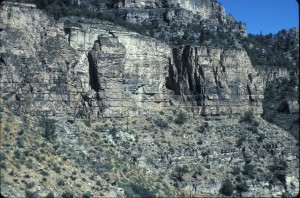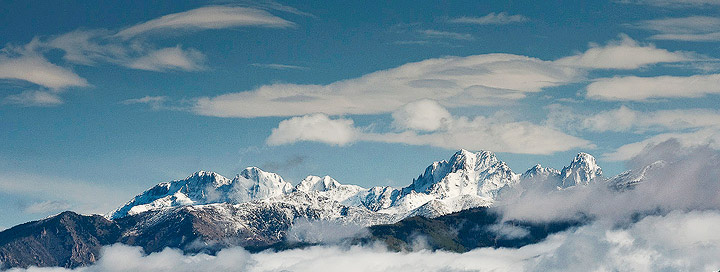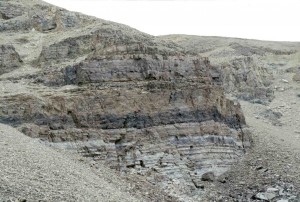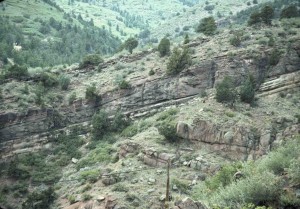Cambrian–Ordovician of the western U.S.
I have been working on Cambrian–Ordovician boundary strata in the Rocky Mountain region for ~15 years, primarily with John Taylor (Indiana U. of Pennsylvania), Robert Ripperdan (St. Louis U.), Jim Miller (SW Missouri State), Ray Ethington (U. of Missouri), and Jim Loch (U. of Central Missouri) and numerous Colorado College students. We have an extraordinary suite of integrated sedimentological, biostratigraphic, chemostratigraphic, and sequence-stratigraphic data for the full length of the U.S. Rockies. We presented a depositional model for inner detrital belt facies (Myrow et al., 2012) that highlight the difference between mixed siliciclastic–carbonate facies in these settings relative to shelf settings.
Our present focus is to look at the geochemical signature of biomeres, patterns of extinction and radiation of trilobites and associate taxa. There is much controversy regarding the cause(s) of biomere extinctions. Various authors have appealed to eustatic events, biogeographic shifts, oceanic overturn/destratification, anoxic conditions, and/or incursions of cool water onto the warm Laurentian epicontinental seaways. We hope to test some of these hypotheses through a combination of detailed sedimentological, stratigraphic, and paleontological studies.
Our work initiated with samples taken across the top of the Pterocephaliid Biomere from locations in southern Montana with CC student Julian Springer, who ran the samples at Harvard University in David Johnston’s lab. We sampled strata in northern Wyoming and southern Montana that record the top of the Ptychaspid Biomere with David Fike (Washington University, St. Louis). Finally, suites of samples have been collected in both southeast New Mexico and east central Colorado in strata that cross the Lower Ordovician Stairsian Stage boundary. This is a trilobite extinction horizon with many of the same characteristics as well-known Late Cambrian biomeres. CC student Kye Birchard ran these samples at Dave Johnston’s Harvard laboratory.

Cliff of Lower Ordovician Manitou Formation and underlying strata of the Upper Cambrian Dotsero Formation.
Publications:
Myrow, P.M., Taylor, J.F., Runkel, A.C., and Ripperdan, 2012, Mixed siliciclastic–carbonate upward-deepening cycles of the Upper Cambrian inner detrital belt of Laurentia: Journal of Sedimentary Research, v. 82, p. 216-231.
Myrow, P.M., Tice, L.P., Archuleta, B., Clark, B., Taylor, J.F., and Ripperdan, R.L., 2004, Flat-pebble conglomerate: its multiple origins and relationship to meter-scale depositional cycles: Sedimentology, v. 51, p. 1-24.
Myrow, P., Taylor, J., Miller, J., Ethington, R., Ripperdan, R., and Allen, J., 2003, Fallen arches: Dispelling myths concerning Cambrian and Ordovician paleogeography of the Rocky Mountain region: Geological Society of America Bulletin, v. 115, p. 695-713.
Additional Details of the Rocky Mountains Project
Photo: Upper Cambrian deposits of the Sawatch Formation near Horseshoe Mountain, outside of Fairplay, Colorado.
- Photo: Glauconite-rich, large-scale, subaqueous, tidal dunes in the Middle Sawatch Formation in Manitou Springs, Colorado (see Myrow, 1996). The Pikes Peak Granite is in the foreground. The dunes have spacings of hundreds of meters and heights of over 3 m. This cross-bedded unit consists of a compound cross-bed set over 6 m thick on the right hand side of the picture.
Refereed Publications/Guidebooks:
- Myrow, P., 1998, Transgressive Stratigraphy and Depositional Framework of Cambrian Tidal Dune Deposits, Peerless Formation, Central Colorado, U.S.A. in Alexander, C., Davis, R., and Henry, J., eds., Tidalites: Processes and Products, SEPM Special Publication No. 61, p. 143-154.
- Myrow, P.M., 1995, Thalassinoides and the enigma of early Paleozoic open-framework burrow systems: Palaios, v. 10, p. 58-74.
- Myrow, P.M., Ethington, R.L., and Miller, J.F., 1995, Cambro–Ordovician proximal shelf deposits of Colorado: Short Papers for the Seventh International Symposium on the Ordovician System, Ordovician Odyssey, p 375-379.
- Myrow, P.M. and Grotzinger, J.P., 2000, Chemostratigraphic proxy records: forward modeling the effects of unconformities, variable sediment accumulation rates, and sampling-interval bias, in Grotzinger, J. and James, N., eds., Carbonate Sedimentation and Diagenesis in the Evolving Precambrian World: SEPM Special Publication 67, p. 43-55.
- Myrow, P., Taylor, J., Miller, J., Ethington, R., Ripperdan, R., and Allen, J., 2003, Fallen arches: Dispelling myths concerning Cambrian and Ordovician paleogeography of the Rocky Mountain region: Geological Society of America Bulletin, v. 115, p. 695-713.
- Myrow, P., Taylor, J., Miller, J., Ethington, R., Ripperdan, R., and Brachle, C., 1999, Stratigraphy, Sedimentology, and Paleontology of the Cambrian-Ordovician of Colorado, in Lageson, D.R., Lester, A., and Trudgill, B., eds., Colorado and Adjacent Areas: Geological Society of America Field Guide, Boulder, CO, p. 157-176.
- Myrow, P., Taylor, J., Miller, J., Ethington, R., Ripperdan, R., Brachle, C., and Owen M., 1999, Stratigraphic synthesis of the Cambrian–Ordovician rocks of Colorado: Acta Universitis Carolinae – Geologica, v. 43, p. 9-12.
- Rigby, J.K. and Myrow, P.M., 1999, Lower Ordovician Sponges from the Manitou Formation in Central Colorado: Brigham Young University Press, v. 44, p. 135-153.


